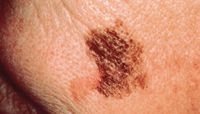- General Dermatology
- Eczema
- Chronic Hand Eczema
- Alopecia
- Aesthetics
- Vitiligo
- COVID-19
- Actinic Keratosis
- Precision Medicine and Biologics
- Rare Disease
- Wound Care
- Rosacea
- Psoriasis
- Psoriatic Arthritis
- Atopic Dermatitis
- Melasma
- NP and PA
- Skin Cancer
- Hidradenitis Suppurativa
- Drug Watch
- Pigmentary Disorders
- Acne
- Pediatric Dermatology
- Practice Management
- Prurigo Nodularis
Article
Popular mnemonic should reflect darkness, not diameter, of skin lesions
Established in 1985, the so-called "ABCD" criteria (assymetry, border, color and diameter) were designed to help laypersons and physicians evaluate suspicious cutaneous lesions and, possibly, make an early diagnosis of potentially curable melanoma. Currently, there is a grassroots move in dermatology to change the "D" criterion from "diameter" to "dark."

Key Points

Over time, the parameter "E" (for evolution) was added to the mnemonic to emphasize the importance of evolving pigmented lesions in the natural process of melanoma progression.
Currently, there is a grassroots move in dermatology to change the "D" criterion from "diameter" to "dark." According to Stuart M. Goldsmith, M.D., F.A.A.D., of Southwest Georgia Dermatology, Albany, Ga., this vital change should aid dermatologists in the recognition of suspicious lesions, and ultimately save more lives.
Worldwide, the incidence of melanoma is on the rise, and in the United States alone, the rate has risen from 7.9 per 100,000 people affected in 1973 to 21.1 per 100,000 in 2006. Most importantly, this alarming rise in melanoma occurrence is associated with an increase in mortality, making earlier detection of melanoma an absolute priority.
According to Dr. Goldsmith, dermatologists must do more to meet this challenge. Unlike cancer surveillance in nearly any other specialty, dermatologists do not require an additional instrument or technique in order to evaluate smaller lesions as opposed to larger lesions. In addition, patients can examine and follow their own lesions at home, regardless of the size of the lesion.
All melanomas probably begin as one cell, and all melanomas exist when smaller than 6 mm. Yet, by the very existence of a diameter criterion, patients are discouraged from looking for the earliest lesions.
"There is an opportunity being missed. Other specialties have had more relative success decreasing the mortality rate from cancers in their specialties than dermatology has, yet other specialties are even more intensively trying to diagnose smaller, and earlier, cancers, and dermatology just doesn't seem to be on the same page as other specialties in terms of early cancer detection," Dr. Goldsmith says.
However, not all experts agree in changing the "D" in the mnemonic from "diameter" to "dark," and the major argument for maintaining the diameter criterion is the specificity argument - i.e., that without a diameter criterion, there would be too many biopsies, resulting in much higher costs.
Dr. Goldsmith analyzed the cost concern in terms of precedent in dermatology, precedent in other specialties, absolute cost per quality-of-life year saved, number of biopsies needed to diagnose melanoma related to sensitivity of diagnosis, and patient expectations.
According to Dr. Goldsmith, none of these arguments validate the cost concern, and, in fact, the total costs related to melanoma would possibly, if not probably, decrease, because of the markedly disproportionate cost due to melanomas diagnosed at a later stage.
"Patients look to the mnemonic as an important guideline and think that these criteria are going to help keep them dying from melanoma, when, in fact, one of the criteria is not there for that purpose, at least not anymore," Dr. Goldsmith says.
"Everyone acknowledges that without a diameter criterion, the sensitivity of diagnosis of early melanoma would improve," he says.
Darkness
The single criterion that seems to be most important to allow recognition of the smaller melanomas is the criterion of darkness. Small melanomas are often recognized solely by their deep, dark pigment and by no other objective finding.
"The feature of darkness," Dr. Goldsmith says, "for identification of these melanomas is a stand-alone, non-redundant feature. When evaluating a lesion of unknown history, an 8 mm, lightly pigmented macule with symmetric variation in pigmentation, with two of four current ABCD features, is of less concern than a 3 mm, circular, evenly pigmented black macule or papule, with zero of four current ABCD features."
Furthermore, darkness usually enhances the diagnosis of melanomas of all sizes in terms of other criteria, such as recognition of change or asymmetry.
When performing a skin exam, perceived darkness can be recognized easily on fair skin, in which melanomas are more common. Moreover, darkness within a mole allows recognition of color variation, which often signifies abnormal pathology.
"I think there is a silent majority of dermatologists who, in their philosophy and in their interaction with patients, pay little heed to the diameter criterion when examining patients, even though it is part of the system. Nonetheless, the diameter criterion remains, and it is difficult to change paradigms.
"The evidence and logic are overwhelming that the diameter criterion is inappropriate, and there is compelling evidence that darkness is a unique, stand-alone, singularly important feature of concern," Dr. Goldsmith says.
The single change of D to stand for "dark" instead of "diameter" in the ABCDE criteria, therefore, would help patients and physicians learn to look for - and to recognize - the smallest melanomas, he says.
According to Dr. Goldsmith, more than 8,000 Americans die each year from melanoma, and most of these deaths are from cutaneous melanomas that are visible, and can be removed in time to save the patient's life, when smaller than 6 mm.
"Why," he asks, "give melanomas a 6 mm head start?"





